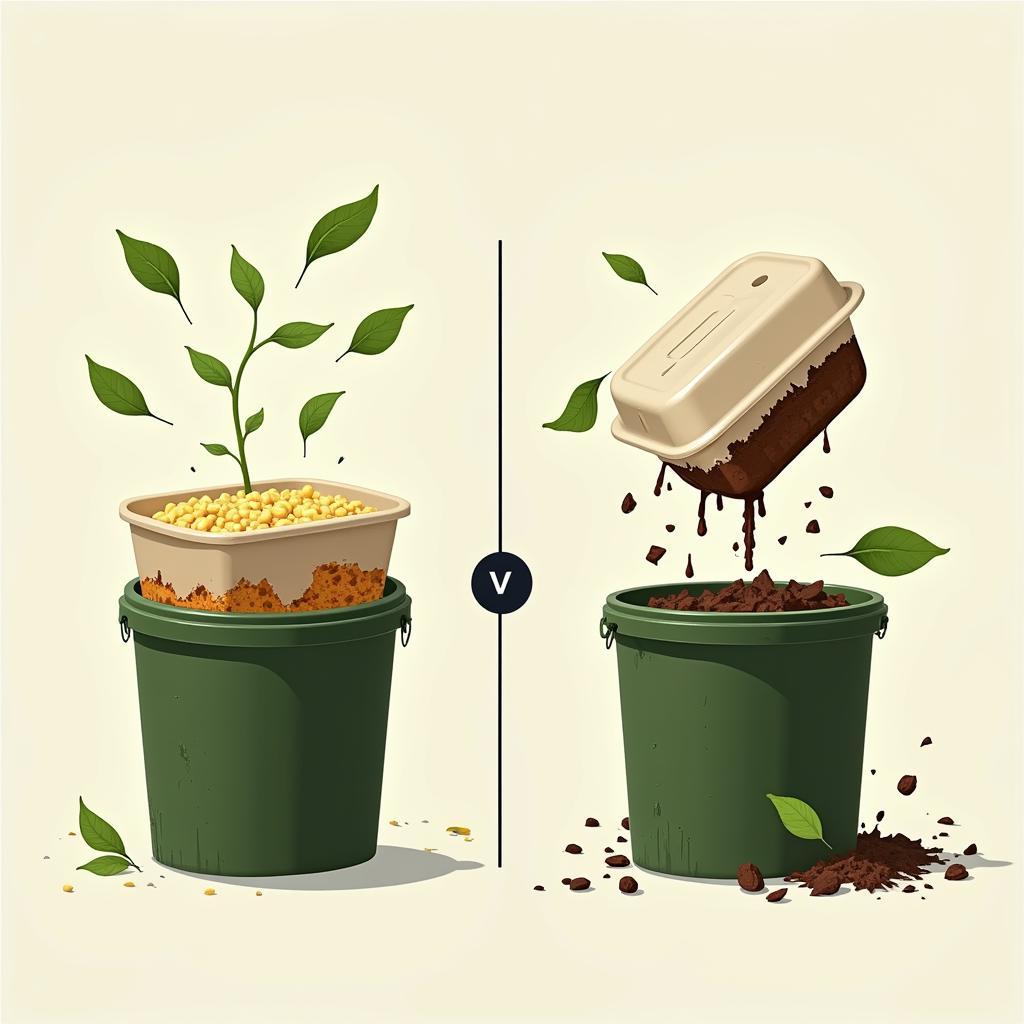Cornstarch Food Containers have emerged as a sustainable and eco-friendly alternative to traditional plastic containers. But what are they exactly, and why are they gaining popularity? In this comprehensive guide, we’ll delve into the world of cornstarch food containers, exploring their benefits, uses, and impact on the environment.
What are Cornstarch Food Containers?
Cornstarch food containers, also known as bioplastic containers, are made from PLA (polylactic acid), a plant-based material derived from cornstarch. This renewable resource makes them a more sustainable choice compared to petroleum-based plastics.
Why Choose Cornstarch Food Containers?
These innovative containers offer numerous advantages:
- Biodegradability: Unlike conventional plastic, cornstarch food containers decompose naturally in composting facilities, reducing plastic waste and its harmful impact on the environment.
- Renewable Resource: Using cornstarch, a readily available and renewable resource, promotes sustainability and reduces our reliance on fossil fuels.
- Safe for Food Contact: Cornstarch food containers are rigorously tested and deemed safe for storing and serving food. They are free from harmful chemicals like BPA, ensuring food safety for you and your loved ones.
Exploring the Versatile Uses of Cornstarch Food Containers
Cornstarch food containers have found their way into diverse applications, including:
- Food Packaging: Restaurants and food businesses are increasingly adopting cornstarch containers for take-out meals, salads, and desserts.
- Food Storage: Their durability and ability to withstand temperature changes make them suitable for storing leftovers in the refrigerator or freezer.
- Events and Catering: Cornstarch food containers offer a sustainable and aesthetically pleasing option for serving food at events and gatherings.
Making the Switch to Biodegradable Containers for Food
The shift towards eco-conscious choices extends beyond cornstarch food containers. Consumers are actively seeking biodegradable options in various aspects of their lives. If you’re looking for more sustainable alternatives, be sure to check out our article on biodegradable containers for food to explore a wider range of options.
Understanding the Decomposition Process
 Cornstarch Container Decomposing in Compost
Cornstarch Container Decomposing in Compost
Cornstarch food containers break down through a natural process called composting. In composting facilities, microorganisms break down the organic material into compost, a nutrient-rich soil amendment. However, it’s important to note that they require specific conditions for proper decomposition and should not be disposed of in regular trash.
Cornstarch Food Containers: A Sustainable Solution
“Choosing cornstarch food containers is a simple yet powerful step towards reducing our environmental footprint,” says renowned environmentalist Dr. Sarah Green. “Their biodegradability and reliance on renewable resources make them a game-changer in the fight against plastic pollution.”
Navigating the Wholesale Market
For businesses seeking cost-effective options, exploring wholesale food containers near me can provide access to bulk discounts and a wider variety of choices.
Cornstarch Food Containers vs. Traditional Plastic: A Comparison
| Feature | Cornstarch Food Containers | Traditional Plastic Containers |
|---|---|---|
| Material | PLA (Polylactic Acid) from Cornstarch | Petroleum-Based Plastic |
| Biodegradability | Biodegradable in Composting Facilities | Non-Biodegradable |
| Renewability | Derived from Renewable Resources | Derived from Non-Renewable Fossil Fuels |
| Environmental Impact | Lower Environmental Impact, Reduces Plastic Waste | Contributes to Plastic Pollution and Environmental Degradation |
The Future of Food Packaging: Embracing Sustainable Solutions
As awareness about environmental issues grows, the demand for sustainable packaging solutions like cornstarch food containers continues to rise. By embracing these eco-friendly alternatives, we can collectively contribute to a healthier planet for future generations.
Frequently Asked Questions
1. Can cornstarch food containers be microwaved?
While some cornstarch containers are microwave-safe, it’s essential to check the manufacturer’s instructions.
2. Are cornstarch food containers as durable as plastic?
Cornstarch food containers are designed for single-use applications and may not be as durable as traditional plastic.
3. How long does it take for cornstarch food containers to decompose?
The decomposition time varies depending on composting conditions, but it typically takes a few months.
4. Can I recycle cornstarch food containers?
Cornstarch food containers are not typically accepted in curbside recycling programs. They should be composted in designated facilities.
5. Are cornstarch food containers more expensive than plastic?
While the cost of cornstarch food containers may be slightly higher, the environmental benefits often outweigh the price difference.
Need More Information on Food Containers?
For those interested in exploring other types of food containers, our article on 4 compartment food containers disposable provides insights into convenient and practical options for meal prepping and portion control.
Looking for creative ways to use food coloring? Our guide on food dye paint offers fun and engaging ideas for arts and crafts projects.
Contact Us!
Need help finding the right food container solution for your needs? Contact our dedicated team at Phone Number: 02437655121, Email: minacones@gmail.com or visit us at 3PGH+8R9, ĐT70A, thôn Trung, Bắc Từ Liêm, Hà Nội, Việt Nam. Our customer care team is available 24/7 to assist you.